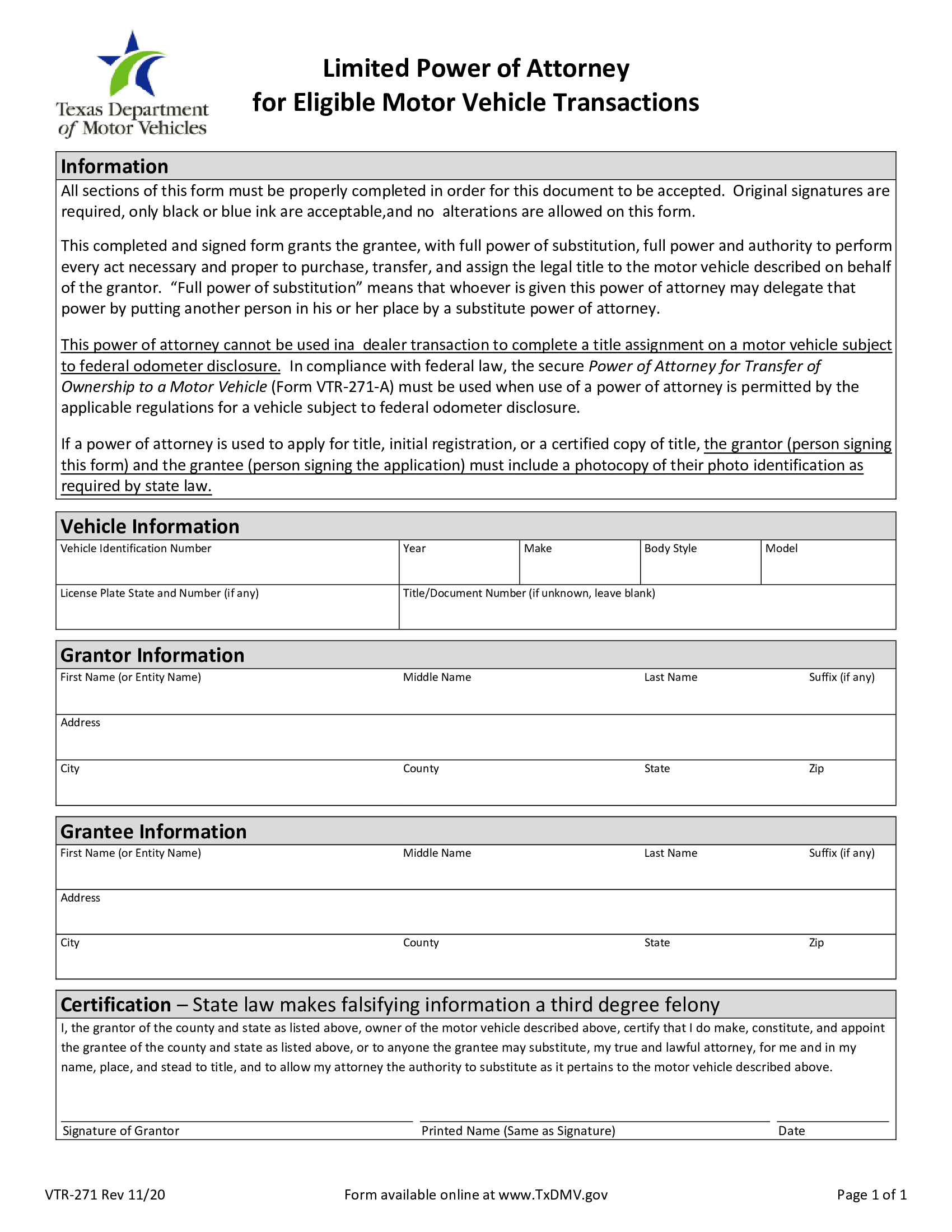Texas Vehicle Power of Attorney
If you want to grant various powers regarding your vehicle to someone else you trust, you cannot avoid signing certain documents in all American states. If you and your vehicle are both based in Texas, and you need to designate a trusted person (or an agent) who will be able to complete different actions with the vehicle, you shall think of signing the Texas vehicle power of attorney (or POA) form, which is officially known as Form VTR-271.
The document’s main purpose is to prove that the agent, usually called the grantee, has the full right to conduct several administrative actions tied to the vehicle and appointed by the grantor or the one who owns the vehicle. Among such actions are title transfer or assignment, purchase, and so on. The document also allows an agent to appoint someone else as a power of attorney for a certain vehicle in Texas.
The form relates only to the vehicles and has nothing to do with other aspects of life. It is not necessary to transfer all rights possible to an agent; their functions may be limited by the grantor, which should be reflected in the vehicle POA template.

Requirements for Signatories
There are some rules and norms every form signatory has to know before completing and signing the form. This information is also written in the official template; however, we would like to draw your attention to some points.
First of all, do not neglect the template’s content. Read every line carefully and fill the form out in accordance with the offered rules and details. No corrections are allowed in the form.
Secondly, a grantor cannot designate as their agent anyone who is a vehicle dealer (or their employer, or their relative) unless the vehicle in question is exempt from the odometer disclosure law. The National Highway Traffic Safety Administration (the part of the United States Department of Transportation) offers current and official information regarding the topic.
You will have to prepare the info about your vehicle’s odometer reading. Do not forget to add this data to the form.
The form does not presume that you have to notarize it. However, signing it is mandatory.
Lastly, it is vital to know that providing fake data to this template is considered a third-degree felony in Texas. If you violate this law, you may end up in jail for a significant period (from two to 10 years; see the Texas Statutes, Penal Code, Title 3, Chapter 12).
Filling Out the Form
If you are wondering how to properly prepare the Texas vehicle power of attorney document (or the Form VTR-271) offered by the government, check our brief guide telling about the step-by-step template completion. If some points are still not clear and you face questions and doubts, try consulting legal specialists or visiting the Texas Department of Motor Vehicles (or DMV) official site. The Department’s specialists will offer you the needed help.
Before you start, remember that you can either type all the form’s content via your computer or download the form and write the data down using your pen. The important thing is that you should use either black or blue ink in both cases.
1. Download the Template
While all templates proposed by the DMV in Texas are located on the official webpage, here, we offer you the very same form that you can download in a couple of seconds. Get the file and open it on your laptop or print the paper.
2. Insert Your Data
You, as a grantor, have to introduce yourself by writing your full name and specify your county in Texas. Enter the required information in the template’s first two lines.

3. Appoint the Agent
You have to add the same info for your grantee or an agent. If they are not a resident of Texas but another American state, indicate the proper location.

4. Describe Your Vehicle
There are certain details about your motor vehicle that you have to declare in Form VTR-271. Among these details are the item’s make and model, year when it was produced, body style, the title certificate number, the license plate number, and, finally, the unique VIN (vehicle identification number). Insert the demanded info in the designated places.

5. Disclose the Odometer Reading
Enter the vehicle’s odometer reading in the designated line. Read the following question and indicate the relevant answer by marking the proper option.

6. Duplicate Your Name and Sign the Form
Write your full legal name again at the end of the form. Below, leave your signature in the designated line.

7. Write Your Full Address
Under your signature, indicate your full address, including state and postal code.

8. Date the Form
Remember to add the current date below the address to make the form valid.

Now, let us answer a few more frequently asked questions regarding the form.
What Should I Do with the Form When It Is Complete?
You have to provide your agent with the copy and store your form in a safe place. The agent will use the form in case they will act on your behalf and conduct some allowed operations with the vehicle. In most cases, they will need to submit the document, among other legal forms, to the Texas DMV.
What If I Want to Cancel the Form?
There is a special revocation form you shall complete in case there is a need to cancel your current vehicle POA. Remember to notarize the revocation form and deliver it to all parties concerned. After you have done all these things, you can legally create the new vehicle POA form and appoint the new agent.
